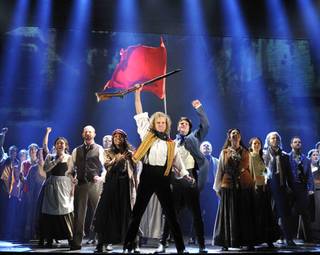
John Burnett, new vice president and chief financial officer of the Smith Center for the Performing Arts, at his office on July 23, 2013. Photo by: Richard N. Velotta
Sun archives
For John Burnett, the chance to work at the Smith Center for the Performing Arts was an opportunity to be center stage at a theater the nation’s arts community has been buzzing about for months.
Burnett was appointed vice president and chief financial officer of the year-old theater last month. His hiring ended a seven-month executive search.
Burnett previously helped open the Adrienne Arsht Center for the Performing Arts in Miami, a $472 million theater that was the largest public-private partnership in South Florida history, and was chief financial officer of the Wang Center for the Performing Arts in Boston and the Center for the Performing Arts at the Woodlands in Houston.
Tell us about your new assignment at the Smith Center.
Hopefully, I’m going to be helping to move it from construction and opening to sustainability. I have some experience doing that.
What exactly does a CFO for a nonprofit performing arts center do?
A CFO helps oversee the strategic side. A lot of it is about policies. These buildings aren’t built for the short term; they’re built for the next 100 years. The policies, procedures, financial oversight and fiduciary responsibility are pretty big.
When you think of smaller performance groups, business acumen isn’t always a part of the process. But with an organization this size, spending has to be controlled to make sure we’re being efficient.
We’re a nonprofit. The people who give money want to know we’re spending it in a responsible way. That’s where I come in.
I tell people I have no artistic ability. I can’t sing, I can’t dance. But at least I can feel proud that I'm helping put out what goes on the stage.
How is the Smith Center funded?
Ticket sales account for about 75 percent of our budget. And we spend almost $1 million on education programs during the year. So we have to raise money through giving.
The Smith Center has done a good job on the ticket-sale side. Seventy-five percent is a good number for performing arts centers.
Part of it is that the Smith Center is held in such high esteem. The first time I went back to Miami to visit my family, I was wearing my Smith Center shirt, and the flight attendant stopped me and told me how proud she was of the Smith Center and how we did it right — there were enough bathrooms for the ladies. No one has ever stopped me to say something like that. Everybody is pretty proud of what we have here.
What challenges do you anticipate?
We have to build our fundraising to cover that other 25 percent. We have to be sure we’re operating efficiently. Everyone here has done a great job of getting it off the ground and running, but as with any center that opens, the second and third years tend to be about stabilizing operations and making sure you have the right people, the right systems and the right controls to prevent overspending, so that you set a good path for the future.
Keeping tickets affordable, paying for education and community outreach, bringing in local performers and our resident companies — all of that takes fundraising. In dollars and cents, that’s more than $3.2 million. Some of that comes as corporate giving, but most of it comes from individuals.
How does the Smith Center compete with casino companies that also provide entertainment?
Las Vegas is different than a lot of other cities. There’s a lot of competition, so finding our niche is an ongoing thing. What plays well in Des Moines or Omaha may not play well here.
For example, Cirque du Soleil used to come through Miami all the time and play at our venue. I don’t think a Cirque show here would do well.
But what our team is doing with the Broadway series is phenomenal.
Is there such a thing as too many subscribers? Sometimes, it can be hard to get individual tickets to shows.
We have 11,000 to 12,000 subscribers. Miami had maybe 5,000. We are the envy of everyone across the country.
But that’s still only 75 percent of what we need to stay open, because we’re doing so much more than just Broadway.

